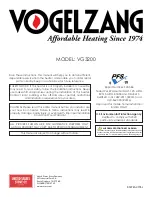
007095315-001
3.2 THE CHIMNEY
Essential requirements for correct appliance operation:
DO NOT CONNECT THIS UNIT TO A CHIMNEY FLUE SERVING ANOTHER APPLIANCE.
THIS APPLIANCE MUST BE CONNECTED TO (1) A LISTED TYPE HT (2100 °F) CHIMNEY PER UL 103 OR ULC S629 OR (2)
A CODE-APPROVED MASONRY CHIMNEY WITH A FLUE LINER.
THE CHIMNEY SIZE SHOULD NOT BE LESS THAN OR MORE THAN THREE TIMES GREATER THAN THE CROSS-SECTIONAL
AREA OF THE FLUE COLLAR.
FOR A CORRECT INSTALLATION PLEASE RESPECT THE SECTIONS/LENGTHS OF THE FLUE SHOWN IN THE TECHNICAL
DATA TABLE. BY INSTALLATIONS WITH DIFFERENT DIMENSIONS THE FLUE MUST BE SUITABLY SIZED IN ACCORDANCE
WITH
CAN/ULC S629 M87 IN CANADA AND TO UL 103 (TYPE HT 2100°F) IN USA
.
WARNING
THE CHIMNEYS USED MUST BE IN ACCORD TO
CAN/ULC S629 M87 IN CANADA AND TO UL 103 (TYPE HT 2100°F) IN USA.
THE FLUE MUST BE AT A SUITABLY DISTANCE FROM FLAMMABLE OR COMBUSTIBLE MATERIAL USING SUITABLE
INSULATION OR AN AIR SPACE.
IT IS FORBIDDEN TO CREATE MOVEABLE OR FIXED OPENINGS ON THE FLUE ITSELF, FOR THE CONNECTION OF FURTHER
DIFFERENT APPLIANCES (SEE CHAPTER CONNECTING A FIREPLACE OR OPEN HEARTH TO THE FLUE).
3.2.1 CHIMNEY CONNECTOR
The chimney connector must be as short as possible, straight horizontal and positioned slightly in ascent, and watertight.
Connection to the chimney shall be performed attaching and securing the connections with a minimum of three screws to the product
and to each adjoining section.
Connection must be carried out with stable and robust pipes, comply with all current Standards and Regulations and to those
envisioned by the law, and be hermetically secured to the flue.
Chimney Connector size to be used: 24 ga black or blued-steel, 6–
inch diameter. The chimney pressure (DRAUGHT) must be at least
(see chap. TECHNICAL DATA SHEET) Pascal.
The measurement
has always to be carried out with hot device (rated thermal performance).
WHEN THE DEPRESSION ExCEEDS 15 PA (=1.5 MM OF COLUMN OF WATER), IT IS NECESSARY TO REDUCE THE
SAME BY INSTALLING AN AN APPROPRIATE DEvICE ON THE ExHAUST PIPE OR IN THE CHIMNEY, ACCORDING TO
THE REGULATIONS IN FORCE.
WARNING
THE CHIMNEYS USED MUST BE TESTED ACCORDING TO
CAN/ULC S629 M87 IN CANADA AND TO UL 103 (TYPE HT 2100°F) IN USA.
THE FLUE MUST BE PROPERLY SPACED FROM ANY FLAMMABLE MATERIALS OR FUELS THROUGH A PROPER INSULATION
OR AN AIR CAVITY. MINIMUM DISTANCE SAFETY 25 CM.
THE UNUSED FLUE GAS EXHAUST HOLE MUST BE COVERED WITH ITS RESPECTIVE CAP (See Chapter: Dimensions).
FOR CORRECT APPLIANCE OPERATION, IT IS ESSENTIAL THAT SUFFICIENT AIR FOR COMBUSTION IS INTRODUCED INTO
THE PLACE OF INSTALLATION (see paragraph VENTILATION AND AERATION OF THE INSTALLATION PREMISES).
FOR CANADA
: A CHIMNEY CONNECTOR SHALL NOT PASS THROUGH AN ATTIC, ROOF SPACE, CLOSET, FLOOR, CEILING,
OR SIMILAR CONCEALED SPACE. WHERE PASSAGE THROUGH A WALL OR PARTITION OF COMBUSTIBLE CONSTRUCTION IS
DESIRED, THE INSTALLATION SHALL CONFORM WITH CAN/CSA-B365.
3.2.2 CHIMNEY AND CHIMNEY CONNECTOR MAINTENANCE
Inspection, maintenance, and cleaning of the chimney and chimney connector shall be guaranteed to handle the potential formation of
Creosote.
When wood is burned slowly, it produces tar and other organic vapors, which combine with expelled moisture to form creosote. The creosote
vapors condense in the relatively cool chimney flue of a slow-burning fire. As a result, creosote residue accumulates on the flue lining. When
ignited this creosote makes an extremely hot fire. When burning wood, the chimney connector and chimney should be inspected at least
once every two months during the heating season to determine if a creosote buildup has occurred.
18
Содержание ROSA REVERSE UL-C
Страница 2: ...007095315 001 2 ...
Страница 38: ...38 ...
Страница 39: ...39 ...
Страница 42: ...FRANCAIS 2 007095315 001 ...
Страница 78: ...FRANCAIS 38 007095315 001 ...
Страница 79: ...FRANCAIS 39 007095315 001 ...
















































